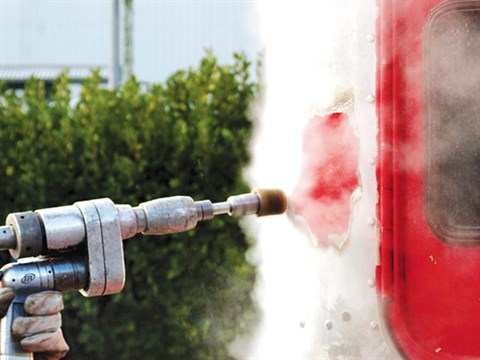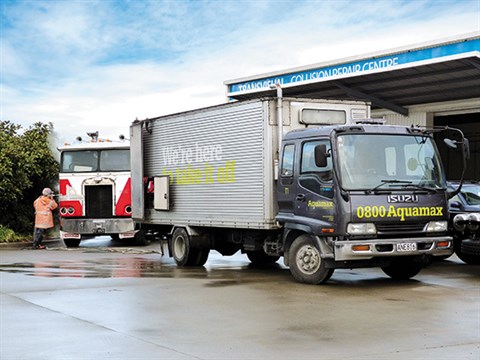Business profile: Aquamax water blasters
 Part way through the paint-strip.
Part way through the paint-strip.

 Drew Currie paint-strips the Kenworth's cab.
Drew Currie paint-strips the Kenworth's cab.





 30hp Lister diesel engine.
30hp Lister diesel engine.




|
|
Part way through the paint-strip.
|

|
|
Drew Currie paint-strips the Kenworth's cab.
|

|

|

|
|
30hp Lister diesel engine.
|

|
Whether the job is on Auckland's Sky Tower or something a little more down to earth, like removing paint from a classic Kenworth truck, Aquamax has the right water jetting tool for the job.
Deals on Wheels went along to the Transvisual Refinish Centre to see the water jetting process at work on the front panels of a 1981 K124 Kenworth currently being given a tidy-up at Transvisual's Wiri premises.
Transvisual director Richard Ryan had called on Aquamax to perform the paint removal from the vehicle as a means of ensuring every vestige of paint would be removed from the Kenworth's trademark rivets and its surrounding panels.
Ryan told DOW that using water-jetting to remove paint was a far more cost and time-effective means of completing the job than using conventional paint stripping methods.
Water jetting is so effective that most aircraft repairers and restorers have abandoned the use of chemical stripping and the associated scraping and sanding that were also a part of the process.
In essence, the task of water jetting the paint from the Kenworth was no different to working on an aircraft and the job was completed in less time than it would have taken using a chemical strip. Also, a better finish was achieved, leaving the rivets intact without any chemical or sand residue in the seams," says Ryan.
Check out this video of Aquamax in action.
Time was of the essence on this job, as the truck needed to be completed and back on the road for the upcoming Kenworth gathering in early September," he says.
The man on the water-jetting gun was Drew Currie, ably assisted by John Stephenson. Both men have a combined eighteen years of service with Aquamax.
Aquamax northern regional manager Chris Mackenzie was on hand to answer any questions, all of which needed to be asked at a safe distance from the working-area in which ear protection was definitely a requirement, due to the surrounding engine noise.
Mackenzie explained that in order to perform effective paint removal from the substrate, pressures in the vicinity of thirty to forty-five thousand psi were required.
A glance at the pump's pressure gauge revealed that in this instance the pump was running at 35,000psi.
Mackenzie went on to explain that, aside from the water pressure requirement, the other factor involved is flow rate.
Aquamax operates a fleet of mainly truck-mounted Woma and Cougar pumps, capable of producing that magical 30,000-45,000psi at a rate of between 4.5 and 20 litres per minute.

Currently there are three trucks each in Auckland and Wellington and a unit has recently been deployed in Christchurch. Each unit is manned by two operators.
Hamish Coop, CEO of Aquamax, whom it seems prefers to play down his PhD in fluid mechanics, explained how the water-jetting process works…
The power driving Aquamax water-jetting equipment is generally supplied via a four-cylinder, 30-horsepower Lister diesel engine, although the company also operates units which are powered by six-cylinder John Deere engines outputting around 130hp.
Aquamax also operate electric pumps for use in confined spaces where carbon monoxide emission and noise levels could present an issue, although both Coop and Mackenzie are quick to point out that that each truck is equipped with around 200 metres of hose which gives good access to most sites.
Water-jetting devices, Coop says, differ immensely from water blasters that traditionally operate at much lower pressures. Your average handyman type of blaster for instance would produce between 1100psi and 3000psi.
Coop says Aquamax water jetting equipment consists of a range of ceramic piston-type, ultra-high-pressure positive displacement pumps that deliver pressurised water to perform a wide range of applications.
Pressures can be operator-adjusted to range from 500bar to 3100bar (45,000psi) depending on the application.
The high pressure water is pumped through a range of pneumatically-driven blasting heads rotating at between 2000rpm – 3000rpm.
The specialised heads are fitted with high quality nozzles with sapphire inserts that can withstand the very high pressures. Deck mowers can also be attached when dealing with larger surface areas.
The deck mowers are also used for road-marking removal and stripping paint, oil, and corrosion from decks of ships, oil rigs, and the like.
The ability to operate at very low flow rates of between four and 18 litres per minute reduces the amount of run-off, making the process user-friendly in the likes of an occupied building.
However, any residue is always vacuumed away at the end of the job and disposed of appropriately.
Each truck carries approximately 2000 litres of water onboard, which is enough to allow for a full day's jetting. It's necessary to filter the water to 0.3 microns in order to pass through the fine tolerances in the jets.
This has the added benefit of removing minerals and chemicals which can adversely affect surfaces, leaving the best possible 'starting point' when it comes to prepping the surface for repainting, along with conserving any visual history of previous repairs and in many cases, remnants of historical signage and livery.
The Aquamax guys are also specialists in the field of hydrodemolition, removing concrete spalling in order to carry out remedial work on reinforced concrete, one advantage of which is the lack of structure-borne noise, a significant plus when working on occupied buildings.

The applications of water jetting are as numerous as the industries in which the process is employed, including:
Scabbling/aggregate exposure
Water jetting is an ideal tool for scabbling and cleaning of surfaces prior to commencing further work and surfaces can be presented with a typically- specified amplitude of up to 10mm.
Stencilling
The process is capable of exposing aggregate on hardened concrete and by utilising a custom-made steel stencil, creating innovative effects, such as greetings or artistic patterns, to add value to what might otherwise be a plain concrete surface.
Heritage buildings
Many heritage buildings require removal of years of paint, plaster and dirt, to reveal detailed stone work.
Paint and corrosion removal
Water jetting is an ideal option for removal of paint and corrosion from a range of substrates, most commonly steel, aluminium and concrete and the process can leave a finish specified to the SSPC/NACE standards. If the coating contains hazardous substances, such as lead, Aquamax can ensure waste is contained and disposed via a certified process.
Roadway and car park marking removal
The company is certified to operate under traffic management conditions on level1 roads. All trucks are equipped with a full signage kit.
For the latest news and reviews, subscribe to Deals On Wheels magazine here.
Keep up to date in the industry by signing up to Deals on Wheels' free newsletter or liking us on Facebook.

.jpg)

.jpg)

.jpg)

